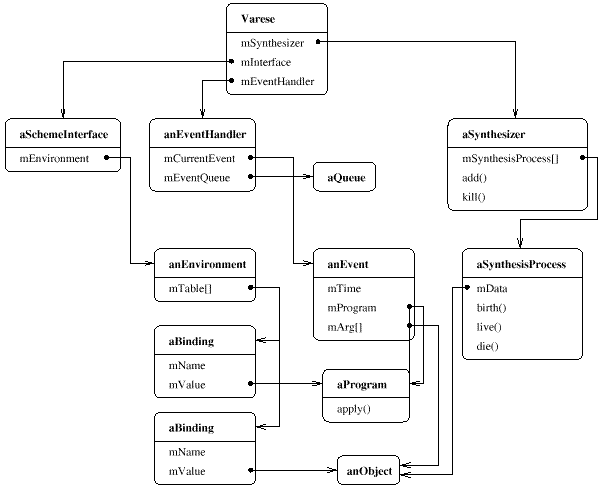|
|
| 5.1 The pillars of the architecture |
|
|
|
In this section we discuss the main components of the system. We will build the system using an object-oriented approach. In particular, the current prototype is completely written in the Java programming language. Considering the formal model, and, adding to that the Scheme shell, we can isolate three distinct tasks: the synthesis, the event handling, and the interaction with the user. The three tasks execute simultaneously; we will embed each of them in its own thread. One object, called Varèse, sets up all the tasks. The first task is the sound synthesis. The system handles this in real-time, which means that the synthesis and the output are interleaved. One buffer of sample frames is synthesized then written to the output device. The synthesizer holds an array of references to active synthesis processes (Fig. 5.1). A new synthesis process can be added to the array by sending an add message to the synthesis thread. A kill message will make an end to the scheduling of a synthesis process and remove it from the array. Each synthesis process produces sound according to its own algorithm. The synthesizer calls the active synthesis processes every tau seconds and passes it a reference to the output buffer. The synthesis process can manipulate the buffer according to its algorithm. The synthesizer then writes the buffer to the output device. A particular synthesis process is a subclass of the abstract class SynthesisProcess. The three key methods of this class are: birth, live, and die. Subclasses must implement these three methods that define the synthesis algorithm the process embodies. We will discuss these methods in more detail in chapter 7.
The second task the system handles is the event processing. At any time, asynchronous to the sound synthesis, events can arrive. Events can be sent from schedulers, programs, or synthesis processes. Events are processed by the event handler. New events are posted to an events queue (figure 5.1). The event handler picks the first event out of the queue, removes it from the queue, and applies the event's program with the given arguments. The program can create, add, and kill synthesis processes. It can modify the state of the system on which the synthesis processes depend, and thus influence the output of the synthesis. It can also define new events, variables, or programs. The time indication of the event is meant mainly for event schedulers. It is ignored by the event handler: once the event is posted to the event queue, it will be handled as soon as possible. The event's program must implement the method apply defined by the interface Program. The last task is the interaction with the user. The music system we present in this text incorporates a Scheme interpreter. This interpreter allows the dynamic definition of both variables and programs. Composers interact with the interpreter to create musical structures, algorithms, synthesis processes, and control structures. A discussion and example of some these structures is given in this and the following chapter. The text entered by the user in the Scheme shell is parsed and evaluated by the interpreter. The evaluation of textual expression can be seen as event handling, and this is why the formal model in the previous chapter does not explicitly mention the user interaction. To call the Java objects from within the shell we have defined a set of Scheme functions. This interface will be discussed in section 5.2. We have three basic tasks (synthesis, event handling, and the interpreter) and three basic objects (programs, events, and synthesis processes) in our environment. The event handler processes the events by applying their program. The interpreter parses and evaluates ``textual'' events. The synthesizer handles the synthesis by calling upon all the active synthesis processes. So far, we have not detailed these synthesis processes very much. In section 5.3 we discuss how to describe and control complex synthesis processes. In section 5.4 we discuss how this environment can be used in distributed applications. In this case all external interaction with the environment - event handling, Scheme interaction, and sound output - is handled over the network.
|
|
|
|
|
